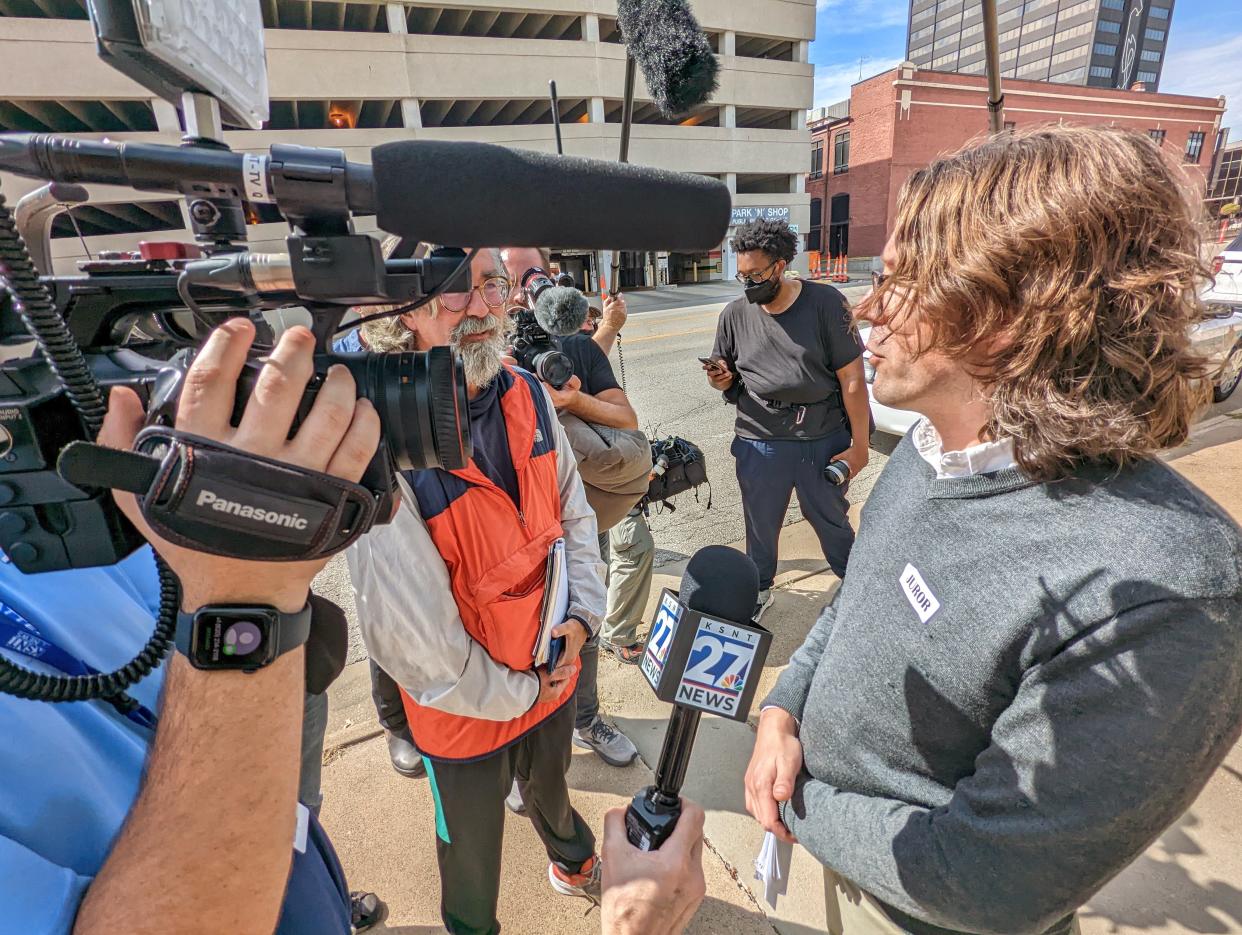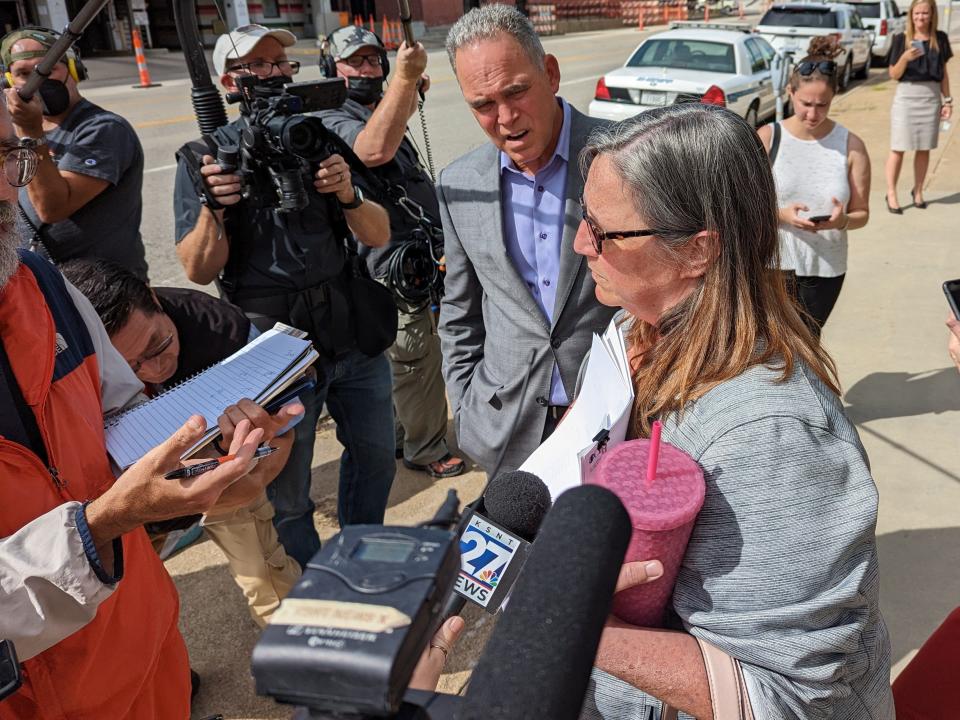Jurors split 7-5 on convicting Dana Chandler. Two members shared why they couldn't vote 'guilty.'

- Oops!Something went wrong.Please try again later.
For about half the jury, the evidence simply wasn't there to convict Dana Chandler of the 2002 killings of her ex-husband Mike Sisco and his fiancée Karen Harkness.
About an hour after jury foreman Ben Alford told Shawnee County District Court Judge Cheryl Rios that the jury couldn't reach a verdict, Alford and Carrie Kimes, another member of the jury, explained why jurors couldn't reach consensus over 40 hours of deliberations.
The jury, having started deliberations Aug. 25, had started with a pretty even split that inched either way multiple times over six days of deliberations. Jurors voted multiple times each day by show of hands and by anonymous cards to gauge the effect of deliberations.
But even with multiple polls each day, the vote rarely changed much. The closest the jury came to unanimity was an 8-4 stance to convict Chandler, although deliberations remained civil throughout. The jury ended deliberations with seven members voting to convict and five to acquit.
More: Dana Chandler's second murder trial ends in hung jury
Without a definitive vote either way, Chandler remains in custody until a status conference on Sept. 29, at which point Rios could declare a mistrial. That would leave open the possibility of trying Chandler a third time, after an original 2012 conviction was overturned by the Kansas Supreme Court on grounds of prosecutorial misconduct.
But such a decision would be up to Shawnee County District Attorney Mike Kagay, and he declined to comment to The Capital-Journal before first visiting with members of the Sisco and Harkness families.
Why some jurors couldn't find Dana Chandler guilty
For Alford, he could see how Chandler would have a motive to kill Sisco and Harkness, but he didn't believe the prosecution had proved intent.
"Was there enough disdain or hatred for the victim to infer the intent to commit the crime?" Alford supposed. "That was the core argument, can you make that leap of faith that yes, was that person disliked, but disliked to that point, and was the person willing to go that far? Some of us thought that there wasn’t any statement or thing to make you say this was beyond a reasonable doubt."
He and Kimes said none of the jurors had put any weight behind the testimony of Terri Anderson, a last-minute witness who appeared unexpectedly during the trial and prompted a multi-day recess in the proceedings.
Anderson, a former neighbor of Harkness, had been talking with a hairdresser client in the trial's early days when she told the client she had heard gunshots and seen Chandler leaving the house after supposedly committing the murders. That client then notified Hailey Seel (the daughter of Mike Sisco and Dana Chandler), who informed authorities.
Previously: Prosecution says Dana Chandler murdered in fit of rage and jealousy. Defense suggests conspiracy.
On the stand, Anderson further claimed she had called 911 to report what she had seen that night, and that she had discussed the incident with investigators the following day.
But no available records can corroborate any part of her story, and Anderson's supposed viewpoint of the Harkness home that night would have likely been obscured.
"The defense said it best in their closing arguments, that it was a little insulting (to put Anderson on the stand)," Alford said. "The story, even on the stand, changed a few times, and it seemed like a Hail Mary pass. There just wasn’t much weight there."
Kimes put more stock in the prosecution and said she understood that lead prosecutor Charles Kitt's job was to simply present all available evidence and allow the jury to determine if Anderson was credible, which they didn't.
More: With limited physical evidence, Dana Chandler gets a second day in court
Jury pained over testimony of Dana Chandler and Mike Sisco's children

One common theme during deliberations was the testimony of the couple's children, Hailey Seel and Dustin Sisco. At one point, the jury requested a readback of Seel's testimony, and they also inquired if they could take into account Chandler's demeanor throughout the trial.
Alford said the jury constantly discussed the children's testimony, especially in considering how difficult it would be for a child to testify against a parent.
"It made it hard, knowing that the kids were hurt," Alford said. "I think it was obvious, and you could see it, but the prosecution wasn’t there to put the whole case together."
More: Jury continues deliberations Monday in Dana Chandler murder trial after some testimony read again
At the end of more than a month of jury selection, trial arguments and deliberation, Kimes said she still couldn't say for sure if Chandler could have committed the killings, but it wasn't her place to say so.
"I was not pleased to have been selected, but I had a job to do," she said. "I took it very seriously, and I was going to look at all the evidence and base my decision on the judge’s instructions on whether the prosecution could prove her guilty beyond a reasonable doubt."
Rafael Garcia is an education reporter for the Topeka Capital-Journal. He can be reached at rgarcia@cjonline.com or by phone at 785-289-5325. Follow him on Twitter at @byRafaelGarcia.
This article originally appeared on Topeka Capital-Journal: Dana Chandler jurors explain why they couldn't reach a verdict

